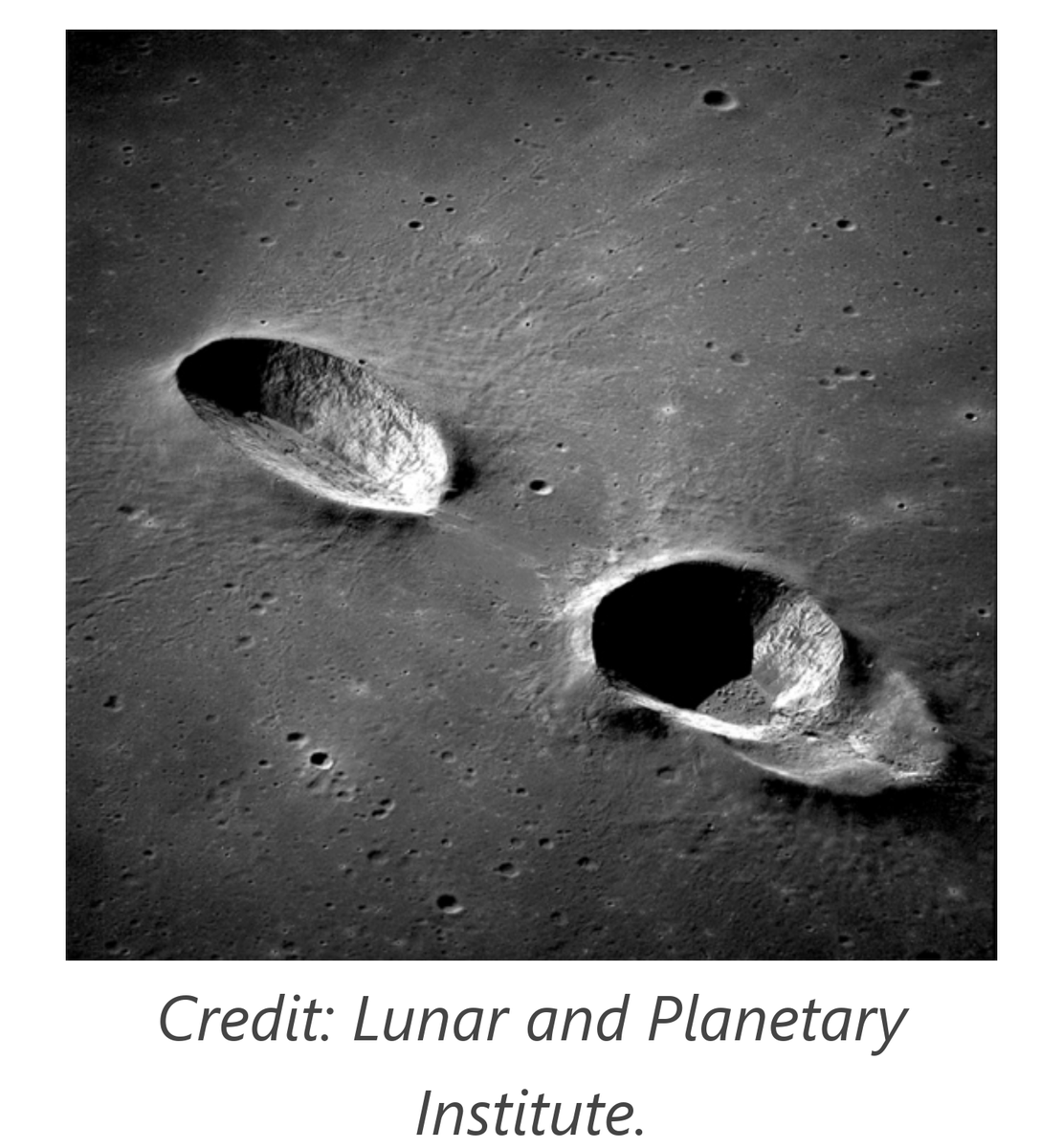[Lunar Crater Anomalies 月のクレーターの異常]
Stephen Smith May 7, 2014Picture of the Day

Messier crater (left) and Messier A from Apollo 11.
アポロ11号からのメシエ・クレーター(左)とメシエA。
――――――――
May 08, 2015
月の細長いクレーターは「放牧インパクター」から来ていると言われています。
故エイミー・アチソンによる今日の写真の初期の1つで、質問されました、どうやってクレーターを作りますか?
天文学者が何世紀も前に月を観測し始めたとき、そこのクレーターは火山の噴出口の残骸であると考えられていました。
望遠鏡の分解能が上がるにつれて、月のクレーターの構造が異常であることがわかりました。
平らな床と中央の山頂は、月のクレーターのかなりの割合を特徴づけます。
残っているものの大部分は明確に定義された円錐形の穴で、側面はきれいで、周囲に破片の形跡はありません。
むしろ、壁が崩れて溶けて見える場合もあります。
〈http://2.bp.blogspot.com/_jiy24EN4vcc/SxK5aeeceCI/AAAAAAAAACI/1oTqt5X0qaA/s1600/Sacrobosco-08-03-07.jpg〉
〈http://www.lroc.asu.edu/news/uploads/LROCiotw/M154785423_WAC.png〉
ページ上部の画像には、「豊穣の海」のクレーター・グループの2つのメンバーが写っています。
彼らの従来の説明は、巨大な小惑星が月に一撃を加え、細長いメシエ・クレーターをすくい取り、それから表面に跳ね返り、そこでメシエA層を掘削してから宇宙に戻ったというものです。
クレーター層の近く、特に長軸境界の外側には噴出物がないので、衝突による破片はどこにありますか?
高速ストライクに伴うエネルギーを生き残るための天体の能力にも疑問があります。
特に、2つのクレーターの長さはそれぞれ15 X8キロメートルと16X11キロメートルであるためです。
月には他にもいくつかの細長いクレーターがあり、火星には他のクレーターがあります。
〈https://moon.nasa.gov/resources/92/new-craters-on-the-moon/〉
〈http://weirdwarp.com/wp-content/uploads/2010/03/elongate-crater.jpg〉
それらには共通の特徴があります:
平らな床、急な壁、衝撃の噴出物の欠如、そして新鮮な外観。
電気的宇宙仮説は、観測に関する別の視点を提供します。
地球物理学のコンセンサス理論では利用できないいくつかの要因が関係しています、これは、利用可能な説明の用語集に、電気アークや移動する地下放電が含まれていないためです。
もちろん、クレーターについては多くの考えられる説明がありますが、しかし、それらの説明の検索に電気力が含まれると、世界を見る新しい方法が可能になります。
導電性の表面が負の電荷を帯びている場合、アークが移動し、議論中のような細長いクレーターを侵食することがあります。
電気的解釈は、月のクレーターを支配する地形の性質を説明しています。
表面に拘束されたバークランド電流間の電磁力は、それらを強制的に整列させます。
イオン風は物質を持ち上げて電流の方向に運ぶことができるため、メシエクレーターに関連する「光線」を説明します。
興味深いことに、月には磁気圏はありませんが、一部の領域には「印加された」磁場があります。
磁気と電気は結びついているのに、異常な磁気の兆候に直面したときに惑星科学者にとってなぜそれは不可解なのですか?
電界がそれらの天体に衝突し、残留磁区を残していると結論付けるのは不合理でしょうか?
もしそうなら、それは「電気的クレーター」の証拠です。
スティーブン・スミス
――――――――
May 08, 2015
Elongated craters on the Moon are said to come from “grazing impactors.”
月の細長いクレーターは「放牧インパクター」から来ていると言われています。
In one of the earliest Pictures of the Day by the late Amy Acheson, the question was asked, how do you make a crater?
故エイミー・アチソンによる今日の写真の初期の1つで、質問されました、どうやってクレーターを作りますか?
When astronomers began to observe the Moon centuries ago, the craters there were considered to be the remains of volcanic vents.
天文学者が何世紀も前に月を観測し始めたとき、そこのクレーターは火山の噴出口の残骸であると考えられていました。
As telescopes advanced in their resolving power, the structure of lunar craters was found to be anomalous.
望遠鏡の分解能が上がるにつれて、月のクレーターの構造が異常であることがわかりました。
Flat floors and central peaks characterize a significant percentage of lunar craters.
平らな床と中央の山頂は、月のクレーターのかなりの割合を特徴づけます。
The majority of those that remain are well-defined, conical holes with clean sides and no evidence of debris surrounding them.
残っているものの大部分は明確に定義された円錐形の穴で、側面はきれいで、周囲に破片の形跡はありません。
Rather, they appear melted with slumping walls in some cases.
むしろ、壁が崩れて溶けて見える場合もあります。
〈http://2.bp.blogspot.com/_jiy24EN4vcc/SxK5aeeceCI/AAAAAAAAACI/1oTqt5X0qaA/s1600/Sacrobosco-08-03-07.jpg〉
〈http://www.lroc.asu.edu/news/uploads/LROCiotw/M154785423_WAC.png〉
In the image at the top of the page, two members of a crater group in Mare Fecunditatis are shown.
ページ上部の画像には、「豊穣の海」のクレーター・グループの2つのメンバーが写っています。
The conventional explanation for them is that a massive asteroid struck the Moon a glancing blow, scooping out the elongated Messier crater and then bounding back to the surface, where it excavated the Messier A formation before returning to space.
彼らの従来の説明は、巨大な小惑星が月に一撃を加え、細長いメシエ・クレーターをすくい取り、それから表面に跳ね返り、そこでメシエA層を掘削してから宇宙に戻ったというものです。
There are no ejecta anywhere near the crater formations, particularly outside of the long axis boundaries, so where is the debris from the impact?
クレーター層の近く、特に長軸境界の外側には噴出物がないので、衝突による破片はどこにありますか?
The ability of an object to survive the energies involved with a high-velocity strike is also questionable.
高速ストライクに伴うエネルギーを生き残るための天体の能力にも疑問があります。
Especially since the two craters measure 15 X 8 kilometers and 16 X 11 kilometers, respectively.
特に、2つのクレーターの長さはそれぞれ15 X8キロメートルと16X11キロメートルであるためです。
There are several other elongated craters on the Moon, and others on Mars.
月には他にもいくつかの細長いクレーターがあり、火星には他のクレーターがあります。
〈https://moon.nasa.gov/resources/92/new-craters-on-the-moon/〉
〈http://weirdwarp.com/wp-content/uploads/2010/03/elongate-crater.jpg〉
They have features in common: flat floors, steep walls, lack of impact ejecta, and a fresh appearance.
それらには共通の特徴があります:
平らな床、急な壁、衝撃の噴出物の欠如、そして新鮮な外観。
The Electric Universe hypothesis offers another perspective on the observations.
電気的宇宙仮説は、観測に関する別の視点を提供します。
Several factors come into play that are not available to the consensus theories of geophysics because the lexicon of descriptions available to them does not include electric arcs or traveling subterranean electric discharges.
地球物理学のコンセンサス理論では利用できないいくつかの要因が関係しています、これは、利用可能な説明の用語集に、電気アークや移動する地下放電が含まれていないためです。
There are, of course, many possible explanations for craters, but once the electric force is included in the search for those explanations a new way of seeing the world becomes possible.
もちろん、クレーターについては多くの考えられる説明がありますが、しかし、それらの説明の検索に電気力が含まれると、世界を見る新しい方法が可能になります。
If the conductive surface carries a negative charge, an arc will travel, sometimes eroding elongated craters, like those under discussion.
導電性の表面が負の電荷を帯びている場合、アークが移動し、議論中のような細長いクレーターを侵食することがあります。
The electrical interpretation explains the nature of the topography dominating the craters on the Moon.
電気的解釈は、月のクレーターを支配する地形の性質を説明しています。
Electromagnetic forces between Birkeland currents constrained to a surface will force them into alignment.
表面に拘束されたバークランド電流間の電磁力は、それらを強制的に整列させます。
Ionic winds can lift material and carry it along in the direction of the current flow, thus explaining the “rays” associated with the Messier craters.
イオン風は物質を持ち上げて電流の方向に運ぶことができるため、メシエクレーターに関連する「光線」を説明します。
An interesting note is that there is no magnetosphere on the Moon, but some areas possess an “impressed” magnetic field.
興味深いことに、月には磁気圏はありませんが、一部の領域には「印加された」磁場があります。
Since magnetism and electricity are bound together, why is it puzzling for planetary scientists when confronted with anomalous magnetic signatures?
磁気と電気は結びついているのに、異常な磁気の兆候に直面したときに惑星科学者にとってなぜそれは不可解なのですか?
Would it be unreasonable to conclude that an electric field impinged on those bodies, leaving behind a remanent magnetic domain?
電界がそれらの天体に衝突し、残留磁区を残していると結論付けるのは不合理でしょうか?
If so, then that is evidence for “electric craters.”
もしそうなら、それは「電気的クレーター」の証拠です。
Stephen Smith
スティーブン・スミス